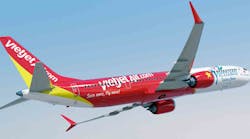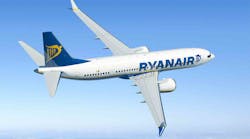Delayed deliveries of the CFM International LEAP engines have slowed delivery rates for Boeing 737 MAX and Airbus A320neo jets, two of the highest-volume aircraft in production by the major OEMs. Both manufacturers reported lower delivery rates for July than for June, a problem attributed to LEAP engine supply delays.
The problem is somewhat more acute for Boeing Commercial Airplanes, according to analysts, because the 737 MAX uses the LEAP-1B engine exclusively, while the A320neo is alternately available with the Pratt & Whitney Geared Turbofan (GTF) engine. Boeing has worked to offset the production-flow problem by increasing output for its previous, 737 Next Generation, and reports have the jet builder completing 737 MAX airframes and setting them aside as they wait for the LEAP-1B engines to complete them.
The decline in deliveries has stirred analysts of both OEMs, but officially Boeing has assured investors that the engine supply matter is within control.
The LEAP-1B is one of three variants for a family of high-bypass turbofan engines developed by CFM, a joint venture of GE Aviation and Snecma, the French aircraft and aerospace group. Each partner manufactures the engines at its own production plants, supplying them to Airbus (the LEAP-1A, for the A320neo), to Boeing (the LEAP-1B, for the new 737 MAX) and to the Commercial Aircraft Co. of China (the LEAP-1C, for the C919 narrow-body jet.)
The LEAP engines remain a fairly recent product introduction for CFM, and the design incorporates various new, lighter materials and part designs in order to achieve better fuel-efficiency and lower carbon emissions. Increasing production rates is considered somewhat more difficult on high-precision systems that rely on numerous suppliers.
One analyst speculated that Boeing may not achieve its optimal 737-MAX delivery rate for two to three years.
All this is unfolding in the midst of an historic expansion in demand for commercial aircraft in general, and in the single-aisle jet sector in particular. Expansion of passenger service in new markets and regions, and replacement of aging fleets in developed markets, has spiked a long-term increase in manufacturing activity for Boeing, Airbus, and other commercial-jet builders, as well as their numerous suppliers.
According to one analysis, nearly 75% of all jet deliveries through 2038 will involve single-aisle jets, including not only the 737 and A320 platforms, but other models Airbus, Bombardier, Embraer, China’s COMAC, and Russia’s Irkut. Production rates are scheduled to increase in line with this demand, but the current problem results from the introduction of new models, which in effect means reestablishing supply chains.
Boeing delivered 29 single-aisle jetliners during July, which reportedly is the lowest monthly delivery total since January 2012. Total jet deliveries for Boeing during the month were just 39, down from 82 during June. Through the first seven months of 2018, Boeing’s 737 deliveries (of both the 737 MAX and the previous version, the 737 Next Generation) totaled 298, only about one-third of which are of the newer 737 MAX design.








